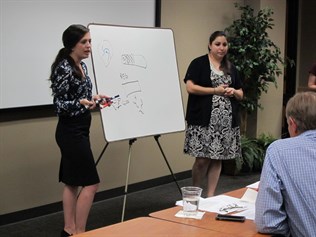
Students from Dwight Look College of Engineering at Texas A&M University were allotted 60 seconds to pitch their research to a panel of judges during the Pitch Your Research competition earlier this month.

The competition, which included participants from the Departments of Materials Science and Engineering, Biomedical Engineering, Mechanical Engineering, Chemical Engineering and Aerospace Engineering, was organized by the Texas A&M Materials Advantage Student Program.
Officers from the program received a grant from the Office of Graduate and Professional Studies to organize the competition.
“The idea for this event originated from our Materials Advantage officers, who felt that describing a technical idea to an industry sponsor, which was not sufficiently covered in the typical current graduate curriculum, was an important part of graduate student training,” said Dr. Patrick J. Shamberger, research assistant professor in materials science and engineering and faculty advisor for the group.

Students from biomedical engineering swept the top three spots. Nick Sears, who pitched his research about a three-dimensional bone printing, won first place. Michael Whitely and Colin Dodson won second place for their pitch about an injectable bone graft material. Stacy Cereceres and Allison Post won third place for their research on a synthetic vascular graft that is resistant to blood clotting.
Judges were industry experts and engineering faculty at Texas A&M. They highlighted common mistakes to avoid when communicating with industry such as using jargon to describe research.
“The importance of communication for students pursuing a career in research is more important than your scientific and technical knowledge,” said Dr. Karl Hartwig, professor in the materials science and engineering department who was one of the judges. “Good communication is crucial for success in all fields of research because it enables advancement and decision making. If there is no clear and appropriate communication, there will be little, if any, impact of the work.